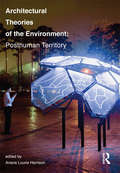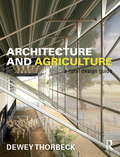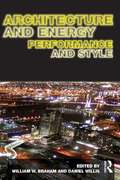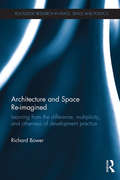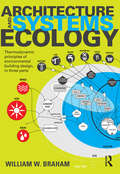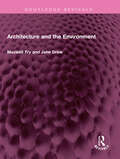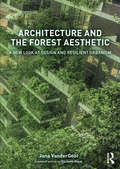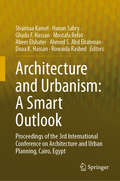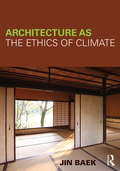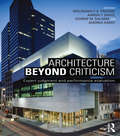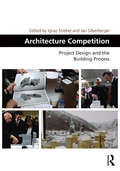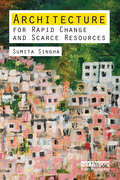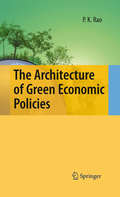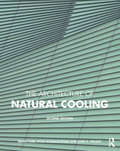- Table View
- List View
Architectural Theories of the Environment: Posthuman Territory
by Ariane Lourie HarrisonAs architects and designers, we struggle to reconcile ever increasing environmental, humanitarian, and technological demands placed on our projects. Our new geological era, the Anthropocene, marks humans as the largest environmental force on the planet and suggests that conventional anthropocentric approaches to design must accommodate a more complex understanding of the interrelationship between architecture and environment Here, for the first time, editor Ariane Lourie Harrison collects the essays of architects, theorists, and sustainable designers that together provide a framework for a posthuman understanding of the design environment. An introductory essay defines the key terms, concepts, and precedents for a posthuman approach to architecture, and nine fully illustrated case studies of buildings from around the globe demonstrate how issues raised in posthuman theory provide rich terrain for contemporary architecture, making theory concrete. By assembling a range of voices across different fields, from urban geography to critical theory to design practitioners, this anthology offers a resource for design professionals, educators, and students seeking to grapple the ecological mandate of our current period. Case studies include work by Arakawa and Gins, Arons en Gelauff, Casagrande, The Living, Minifie van Schaik, R & Sie (n), SCAPE, Studio Gang, and xDesign. Essayists include Gilles Clément, Matthew Gandy, Francesco Gonzáles de Canales, Elizabeth Grosz, Simon Guy, Seth Harrison, N. Katherine Hayles, Ursula Heise, Catherine Ingraham, Bruno Latour, William J. Mitchell, Matteo Pasquinelli, Erik Swyngedouw, Sarah Whatmore, Jennifer Wolch, Cary Wolfe, and Albena Yaneva
Architectural Theories of the Environment: Posthuman Territory
by Ariane Lourie HarrisonAs architects and designers, we struggle to reconcile ever increasing environmental, humanitarian, and technological demands placed on our projects. Our new geological era, the Anthropocene, marks humans as the largest environmental force on the planet and suggests that conventional anthropocentric approaches to design must accommodate a more complex understanding of the interrelationship between architecture and environment Here, for the first time, editor Ariane Lourie Harrison collects the essays of architects, theorists, and sustainable designers that together provide a framework for a posthuman understanding of the design environment. An introductory essay defines the key terms, concepts, and precedents for a posthuman approach to architecture, and nine fully illustrated case studies of buildings from around the globe demonstrate how issues raised in posthuman theory provide rich terrain for contemporary architecture, making theory concrete. By assembling a range of voices across different fields, from urban geography to critical theory to design practitioners, this anthology offers a resource for design professionals, educators, and students seeking to grapple the ecological mandate of our current period. Case studies include work by Arakawa and Gins, Arons en Gelauff, Casagrande, The Living, Minifie van Schaik, R & Sie (n), SCAPE, Studio Gang, and xDesign. Essayists include Gilles Clément, Matthew Gandy, Francesco Gonzáles de Canales, Elizabeth Grosz, Simon Guy, Seth Harrison, N. Katherine Hayles, Ursula Heise, Catherine Ingraham, Bruno Latour, William J. Mitchell, Matteo Pasquinelli, Erik Swyngedouw, Sarah Whatmore, Jennifer Wolch, Cary Wolfe, and Albena Yaneva
Architecture and Agriculture: A Rural Design Guide
by Dewey ThorbeckArchitecture and Agriculture: A Rural Design Guide presents architectural guidelines for buildings designed and constructed in rural landscapes by emphasizing their connections with function, culture, climate, and place. Following on from the author’s first book Rural Design, the book discusses in detail the buildings that humans construct in support of agriculture. By examining case studies from around the world including Australia, China, Japan, Norway, Poland, Japan, Portugal, North America, Africa and the Southeast Asia it informs readers about the potentials, opportunities, and values of rural architecture, and how they have been developed to create sustainable landscapes and sustainable buildings for rapidly changing rural futures.
Architecture and Agriculture: A Rural Design Guide
by Dewey ThorbeckArchitecture and Agriculture: A Rural Design Guide presents architectural guidelines for buildings designed and constructed in rural landscapes by emphasizing their connections with function, culture, climate, and place. Following on from the author’s first book Rural Design, the book discusses in detail the buildings that humans construct in support of agriculture. By examining case studies from around the world including Australia, China, Japan, Norway, Poland, Japan, Portugal, North America, Africa and the Southeast Asia it informs readers about the potentials, opportunities, and values of rural architecture, and how they have been developed to create sustainable landscapes and sustainable buildings for rapidly changing rural futures.
Architecture and Energy: Performance and Style
by William W. Braham Daniel WillisDoes energy consumption influence architectural style? Should more energy-efficient buildings look different? Can that "look" be used to explain or enhance their performance? Architecture and Energy provides architects and architectural theorists with more durable arguments for environmental design decisions, arguments addressing three different scales or aspects of contemporary construction. By drawing together essays from the leading experts in the field, this book engages with crucial issues in sustainable design, such as: The larger role of energy in forming the cultural and economic systems in which architecture is conceived, constructed, and evaluated The different measures and meanings of energy "performance" and how those measures are realized in buildings The specific ways in which energy use translates into the visible aspects of architectural style. Drawing on research from the UK, US, Europe, and Asia the book outlines the problems surrounding energy and architecture and provides the reader with a considered overview of this important topic.
Architecture and Energy: Performance and Style
by William W. Braham Daniel WillisDoes energy consumption influence architectural style? Should more energy-efficient buildings look different? Can that "look" be used to explain or enhance their performance? Architecture and Energy provides architects and architectural theorists with more durable arguments for environmental design decisions, arguments addressing three different scales or aspects of contemporary construction. By drawing together essays from the leading experts in the field, this book engages with crucial issues in sustainable design, such as: The larger role of energy in forming the cultural and economic systems in which architecture is conceived, constructed, and evaluated The different measures and meanings of energy "performance" and how those measures are realized in buildings The specific ways in which energy use translates into the visible aspects of architectural style. Drawing on research from the UK, US, Europe, and Asia the book outlines the problems surrounding energy and architecture and provides the reader with a considered overview of this important topic.
Architecture and Space Re-imagined: Learning from the difference, multiplicity, and otherness of development practice (Routledge Research in Place, Space and Politics)
by Richard BowerAs with so many facets of contemporary western life, architecture and space are often experienced and understood as a commodity or product. The premise of this book is to offer alternatives to the practices and values of such westernised space and Architecture (with a capital A), by exploring the participatory and grass-roots practices used in alternative development models in the Global South. This process re-contextualises the spaces, values, and relationships produced by such alternative methods of development and social agency. It asks whether such spatial practices provide concrete realisations of some key concepts of Western spatial theory, questioning whether we might challenge the space and architectures of capitalist development by learning from the places and practices of others. Exploring these themes offers a critical examination of alternative development practices methods in the Global South, re-contextualising them as architectural engagements with socio-political space. The comparison of such interdisciplinary contexts and discourses reveals the political, social, and economic resonances inherent between these previously unconnected spatial protagonists. The interdependence of spatial issues of choice, value, and identity are revealed through a comparative study of the discourses of Henri Lefebvre, John Turner, Doreen Massey, and Nabeel Hamdi. These key protagonists offer a critical framework of discourses from which further connections to socio-spatial discourses and concepts are made, including post-marxist theory, orientalism, post-structural pluralism, development anthropology, post-colonial theory, hybridity, difference and subalterneity. By looking to the spaces and practices of alternative development in the Global South this book offers a critical reflection upon the working practices of Westernised architecture and other spatial and political practices. In exploring the methodologies, implications and values of such participatory development practices this book ultimately seeks to articulate the positive potential and political of learning from the difference, multiplicity, and otherness of development practice in order to re-imagine architecture and space. .
Architecture and Space Re-imagined: Learning from the difference, multiplicity, and otherness of development practice (Routledge Research in Place, Space and Politics)
by Richard BowerAs with so many facets of contemporary western life, architecture and space are often experienced and understood as a commodity or product. The premise of this book is to offer alternatives to the practices and values of such westernised space and Architecture (with a capital A), by exploring the participatory and grass-roots practices used in alternative development models in the Global South. This process re-contextualises the spaces, values, and relationships produced by such alternative methods of development and social agency. It asks whether such spatial practices provide concrete realisations of some key concepts of Western spatial theory, questioning whether we might challenge the space and architectures of capitalist development by learning from the places and practices of others. Exploring these themes offers a critical examination of alternative development practices methods in the Global South, re-contextualising them as architectural engagements with socio-political space. The comparison of such interdisciplinary contexts and discourses reveals the political, social, and economic resonances inherent between these previously unconnected spatial protagonists. The interdependence of spatial issues of choice, value, and identity are revealed through a comparative study of the discourses of Henri Lefebvre, John Turner, Doreen Massey, and Nabeel Hamdi. These key protagonists offer a critical framework of discourses from which further connections to socio-spatial discourses and concepts are made, including post-marxist theory, orientalism, post-structural pluralism, development anthropology, post-colonial theory, hybridity, difference and subalterneity. By looking to the spaces and practices of alternative development in the Global South this book offers a critical reflection upon the working practices of Westernised architecture and other spatial and political practices. In exploring the methodologies, implications and values of such participatory development practices this book ultimately seeks to articulate the positive potential and political of learning from the difference, multiplicity, and otherness of development practice in order to re-imagine architecture and space. .
Architecture and Systems Ecology: Thermodynamic Principles of Environmental Building Design, in three parts
by William W. BrahamModern buildings are both wasteful machines that can be made more efficient and instruments of the massive, metropolitan system engendered by the power of high-quality fuels. A comprehensive method of environmental design must reconcile the techniques of efficient building design with the radical urban and economic reorganization that we face. Over the coming century, we will be challenged to return to the renewable resource base of the eighteenth-century city with the knowledge, technologies, and expectations of the twenty-first-century metropolis. This book explores the architectural implications of systems ecology, which extends the principles of thermodynamics from the nineteenth-century focus on more efficient machinery to the contemporary concern with the resilient self-organization of ecosystems. Written with enough technical material to explain the methods, it does not include in-text equations or calculations, relying instead on the energy system diagrams to convey the argument. Architecture and Systems Ecology has minimal technical jargon and an emphasis on intelligible design conclusions, making it suitable for architecture students and professionals who are engaged with the fundamental issues faced by sustainable design. The energy systems language provides a holistic context for the many kinds of performance already evaluated in architecture—from energy use to material selection and even the choice of building style. It establishes the foundation for environmental principles of design that embrace the full complexity of our current situation. Architecture succeeds best when it helps shape, accommodate, and represent new ways of living together.
Architecture and Systems Ecology: Thermodynamic Principles of Environmental Building Design, in three parts
by William W. BrahamModern buildings are both wasteful machines that can be made more efficient and instruments of the massive, metropolitan system engendered by the power of high-quality fuels. A comprehensive method of environmental design must reconcile the techniques of efficient building design with the radical urban and economic reorganization that we face. Over the coming century, we will be challenged to return to the renewable resource base of the eighteenth-century city with the knowledge, technologies, and expectations of the twenty-first-century metropolis. This book explores the architectural implications of systems ecology, which extends the principles of thermodynamics from the nineteenth-century focus on more efficient machinery to the contemporary concern with the resilient self-organization of ecosystems. Written with enough technical material to explain the methods, it does not include in-text equations or calculations, relying instead on the energy system diagrams to convey the argument. Architecture and Systems Ecology has minimal technical jargon and an emphasis on intelligible design conclusions, making it suitable for architecture students and professionals who are engaged with the fundamental issues faced by sustainable design. The energy systems language provides a holistic context for the many kinds of performance already evaluated in architecture—from energy use to material selection and even the choice of building style. It establishes the foundation for environmental principles of design that embrace the full complexity of our current situation. Architecture succeeds best when it helps shape, accommodate, and represent new ways of living together.
Architecture and the Environment (Routledge Revivals)
by Maxwell Fry Jane DrewFirst published in 1976 Architecture and the Environment is based on the authors very successful Architecture of Children. The original book has been completely revised and new illustrations have been specially drawn. This book gives a comprehensive account of the role of architecture in the environment of a constantly developing world. It traces the history of building from its most primitive origins to the complex architecture of the current times. The book takes as a starting- point ideas that will be familiar to all its readers, then leads them on to an examination of the attitudes and approaches of architects and planners, so that they can follow the creative process step by step. The style of the book is direct and very readable, with a minimum of technological language and will be useful for general readers interested in architecture.
Architecture and the Environment (Routledge Revivals)
by Maxwell Fry Jane DrewFirst published in 1976 Architecture and the Environment is based on the authors very successful Architecture of Children. The original book has been completely revised and new illustrations have been specially drawn. This book gives a comprehensive account of the role of architecture in the environment of a constantly developing world. It traces the history of building from its most primitive origins to the complex architecture of the current times. The book takes as a starting- point ideas that will be familiar to all its readers, then leads them on to an examination of the attitudes and approaches of architects and planners, so that they can follow the creative process step by step. The style of the book is direct and very readable, with a minimum of technological language and will be useful for general readers interested in architecture.
Architecture and the Forest Aesthetic: A New Look at Design and Resilient Urbanism
by Jana VanderGootDespite population trends toward urbanization, the forest continues to have a strong appeal to the human imagination, and the human preference for forest over many other types of terrain is well documented. This book re-imagines architecture and urbanism by allowing the forest to be a prominent consideration in the language of design, thus recognizing the forest as essential rather than just incidental to human well-being. In Architecture and the Forest Aesthetic, forest is a large-scale urban construct that is far more extensive and nuanced than trees and shrubbery. The forest aesthetic opens designers to the forest as a model for an urban architecture of permeable floors, protective canopies, connected food chains, beneficial decomposition, and resilient ecologies. Much can be learned about these features of the forest from the natural sciences; however, when they are given due consideration technically and metaphorically in the design of urban habitat, the places in which humans live become living forests. What is present here in Architecture and the Forest Aesthetic is both a review of many ingenious ways in which the forest aesthetic has already been expressed in design and urbanism, and an encouragement to further use the forest aesthetic in design language and design outcomes. Case study projects featured include the Chilotan building craft of Southern Chile, the yaki sugi of Japan, the Biltmore Forest in the Southeastern United States, the Australian capital city Canberra, Bosco Verticale in Milan, Italy, the Beijing Olympic Forest Park in China, and more.
Architecture and the Forest Aesthetic: A New Look at Design and Resilient Urbanism
by Jana VanderGootDespite population trends toward urbanization, the forest continues to have a strong appeal to the human imagination, and the human preference for forest over many other types of terrain is well documented. This book re-imagines architecture and urbanism by allowing the forest to be a prominent consideration in the language of design, thus recognizing the forest as essential rather than just incidental to human well-being. In Architecture and the Forest Aesthetic, forest is a large-scale urban construct that is far more extensive and nuanced than trees and shrubbery. The forest aesthetic opens designers to the forest as a model for an urban architecture of permeable floors, protective canopies, connected food chains, beneficial decomposition, and resilient ecologies. Much can be learned about these features of the forest from the natural sciences; however, when they are given due consideration technically and metaphorically in the design of urban habitat, the places in which humans live become living forests. What is present here in Architecture and the Forest Aesthetic is both a review of many ingenious ways in which the forest aesthetic has already been expressed in design and urbanism, and an encouragement to further use the forest aesthetic in design language and design outcomes. Case study projects featured include the Chilotan building craft of Southern Chile, the yaki sugi of Japan, the Biltmore Forest in the Southeastern United States, the Australian capital city Canberra, Bosco Verticale in Milan, Italy, the Beijing Olympic Forest Park in China, and more.
Architecture and Urbanism: Proceedings of the 3rd International Conference on Architecture and Urban Planning, Cairo, Egypt
by Shaimaa Kamel Hanan Sabry Ghada F. Hassan Mostafa Refat Abeer Elshater Ahmed S. Abd Elrahman Doaa K. Hassan Rowaida RashedThis proceedings addresses the challenges of urbanization that gravely affect the world’s ecosystems. To become efficiently sustainable and regenerative, buildings and cities need to adopt smart solutions. This book discusses innovations of the built environment while depicting how such practices can transform future buildings and urban areas into places of higher value and quality. The book aims to examine the interrelationship between people, nature and technology, which is essential in pursuing smart environments that optimize human wellbeing, motivation and vitality, as well as promoting cohesive and inclusive societies: Urban Sociology - Community Involvement - Place-making and Cultural Continuity – Environmental Psychology - Smart living - Just City. The book presents exemplary practical experiences that reflect smart strategies, technologies and innovations, by established and emerging professionals, provides a forum of real-life discourse. The primary audience for the work will be from the fields of architecture, urban planning and built-environment systems, including multi-disciplinary academics as well as professionals.
Architecture as the Ethics of Climate
by Jin BaekAt a time when climate and ethics have become so important to architectural debate, this book proposes an entirely new way for architects to engage with these core issues. Drawing on Tetsuro Watsuji‘s (1889-1960) philosophy, the book illuminates climate not as a collection of objective natural phenomena, but as a concrete form of bond in which "who we are"—the subjective human experience—is indivisibly intertwined with the natural phenomena. The book further elucidates the inter-personal nature of climatic experiences, criticizing a view that sees atmospheric effects of climate under the guise of personal experientialism and reinforcing the linkage between climate and ethos as the appropriateness of a setting for human affairs. This ethical premise of climate stretches the horizon of sustainability as pertaining not only to man’s solitary relationship with natural phenomena—a predominant trend in contemporary discourse of sustainability—but also to man’s relationship with man. Overcoming climatic determinism—regional determinism, too—and expanding the ethics of the inter-personal to the level where the whole and particulars are joined through the dialectics of the mutually-negating opposites, Jin Baek develops a new thesis engaging with the very urgent issues inherent in sustainable architecture. Crucially, the book explores examples that join climate and the dynamics of the inter-personal, including: Japanese vernacular residential architecture the white residential architecture of Richard Neutra contemporary architectural works and urban artifacts by Tadao Ando and Aldo Rossi Beautifully illustrated, this book is an important contribution to the discourse which surrounds architecture, climate and ethics and encourages the reader to think more broadly about how to respond to the current challenges facing the profession.
Architecture as the Ethics of Climate
by Jin BaekAt a time when climate and ethics have become so important to architectural debate, this book proposes an entirely new way for architects to engage with these core issues. Drawing on Tetsuro Watsuji‘s (1889-1960) philosophy, the book illuminates climate not as a collection of objective natural phenomena, but as a concrete form of bond in which "who we are"—the subjective human experience—is indivisibly intertwined with the natural phenomena. The book further elucidates the inter-personal nature of climatic experiences, criticizing a view that sees atmospheric effects of climate under the guise of personal experientialism and reinforcing the linkage between climate and ethos as the appropriateness of a setting for human affairs. This ethical premise of climate stretches the horizon of sustainability as pertaining not only to man’s solitary relationship with natural phenomena—a predominant trend in contemporary discourse of sustainability—but also to man’s relationship with man. Overcoming climatic determinism—regional determinism, too—and expanding the ethics of the inter-personal to the level where the whole and particulars are joined through the dialectics of the mutually-negating opposites, Jin Baek develops a new thesis engaging with the very urgent issues inherent in sustainable architecture. Crucially, the book explores examples that join climate and the dynamics of the inter-personal, including: Japanese vernacular residential architecture the white residential architecture of Richard Neutra contemporary architectural works and urban artifacts by Tadao Ando and Aldo Rossi Beautifully illustrated, this book is an important contribution to the discourse which surrounds architecture, climate and ethics and encourages the reader to think more broadly about how to respond to the current challenges facing the profession.
Architecture Beyond Criticism: Expert Judgment and Performance Evaluation
by Wolfgang F. Preiser Aaron T. Davis Ashraf M. Salama Andrea HardyFor the first time, this book demonstrates that the two paradigms of architectural criticism and performance evaluation can not only co-exist but complement each other in the assessment of built works. As architecture takes more principled stances worldwide, from environmental sustainability to social, cultural, and economic activism, this book examines the roles of perceived and measured quality in architecture. By exploring in tandem both subjective traditional architectural criticism and environmental design and performance evaluation and its objective evaluation criteria, the book argues that both methodologies and outcomes can achieve a comprehensive assessment of quality in architecture. Curated by a global editorial team, the book includes: Contributions from international architects and critics based in the UK, USA, Brazil, France, Qatar, Egypt, New Zealand, China, Japan and Germany Global case studies which illustrate both perspectives addressed by the book and comparative analyses of the findings A six part organization which includes introductions and conclusions from the editors, to help guide the reader and further illuminate the contributions. By presenting a systematic approach to assessing building performance, design professionals will learn how to improve building design and performance with major stakeholders in mind, especially end users/occupants.
Architecture Beyond Criticism: Expert Judgment and Performance Evaluation
by Wolfgang F. Preiser Aaron T. Davis Ashraf M. Salama Andrea HardyFor the first time, this book demonstrates that the two paradigms of architectural criticism and performance evaluation can not only co-exist but complement each other in the assessment of built works. As architecture takes more principled stances worldwide, from environmental sustainability to social, cultural, and economic activism, this book examines the roles of perceived and measured quality in architecture. By exploring in tandem both subjective traditional architectural criticism and environmental design and performance evaluation and its objective evaluation criteria, the book argues that both methodologies and outcomes can achieve a comprehensive assessment of quality in architecture. Curated by a global editorial team, the book includes: Contributions from international architects and critics based in the UK, USA, Brazil, France, Qatar, Egypt, New Zealand, China, Japan and Germany Global case studies which illustrate both perspectives addressed by the book and comparative analyses of the findings A six part organization which includes introductions and conclusions from the editors, to help guide the reader and further illuminate the contributions. By presenting a systematic approach to assessing building performance, design professionals will learn how to improve building design and performance with major stakeholders in mind, especially end users/occupants.
Architecture Competition: Project Design and the Building Process (Design and the Built Environment)
by Ignaz Strebel Jan SilberbergerMuch valued by design professionals, controversially discussed in the media, regularly misunderstood by the public and systematically regulated by public procurement; in recent years, architecture competitions have become projection screens for various and often incommensurable desires and hopes. Almost all texts on architectural competition engage it for particular reasons, whether these be for celebration of the procedure, or dismissal. Moving on from such polarised views, Architecture Competition is a revelatory study on what really happens when competitions take place. But the story is not just about architecture and design; it is about the whole construction process, from the definition of the spatial programme, to judgement and selection of projects and the realization of the building. This book explores the competition in the building process as it takes place, but also before and after its execution. It demonstrates that competitions are not just one step of many to be taken, but that competitive design procedures shape the entire process. Along the way the book exposes, among others, one of the key evolutions of design competitions – that competition procedures need to be regulated in order to respond to public awarding rules and need to integrate an increasing amount of given standards regarding, for example, efficiency, fire safety and thermal comfort. These notions force competing architects to respond to inflexible and overloaded competition programmes instead of focusing on genuinely crafting an architectural project. If the architecture competition wants to be more highly valued as a design tool, it should pay attention to the iterative nature of design and to the fact that perspectives on the problem often change in process.
Architecture Competition: Project Design and the Building Process (Design and the Built Environment)
by Ignaz Strebel Jan SilberbergerMuch valued by design professionals, controversially discussed in the media, regularly misunderstood by the public and systematically regulated by public procurement; in recent years, architecture competitions have become projection screens for various and often incommensurable desires and hopes. Almost all texts on architectural competition engage it for particular reasons, whether these be for celebration of the procedure, or dismissal. Moving on from such polarised views, Architecture Competition is a revelatory study on what really happens when competitions take place. But the story is not just about architecture and design; it is about the whole construction process, from the definition of the spatial programme, to judgement and selection of projects and the realization of the building. This book explores the competition in the building process as it takes place, but also before and after its execution. It demonstrates that competitions are not just one step of many to be taken, but that competitive design procedures shape the entire process. Along the way the book exposes, among others, one of the key evolutions of design competitions – that competition procedures need to be regulated in order to respond to public awarding rules and need to integrate an increasing amount of given standards regarding, for example, efficiency, fire safety and thermal comfort. These notions force competing architects to respond to inflexible and overloaded competition programmes instead of focusing on genuinely crafting an architectural project. If the architecture competition wants to be more highly valued as a design tool, it should pay attention to the iterative nature of design and to the fact that perspectives on the problem often change in process.
Architecture for Rapid Change and Scarce Resources
by Sumita SinhaArchitects, development practitioners and designers are working in a global environment and issues such as environmental and cultural sustainability matter more than ever. Past interactions and interventions between developed and developing countries have often been unequal and inappropriate. We now need to embrace fresh design practices based on respect for diversity and equality, participation and empowerment. This book explores what it means for development activists to practise architecture on a global scale, and provides a blueprint for developing architectural practices based on reciprocal working methods. The content is based on real situations - through extended field research and contacts with architecture schools and architects, as well as participating NGOs. It demonstrates that the ability to produce appropriate and sustainable design is increasingly relevant, whether in the field of disaster relief, longer-term development or wider urban contexts, both in rich countries and poor countries.
Architecture for Rapid Change and Scarce Resources
by Sumita SinhaArchitects, development practitioners and designers are working in a global environment and issues such as environmental and cultural sustainability matter more than ever. Past interactions and interventions between developed and developing countries have often been unequal and inappropriate. We now need to embrace fresh design practices based on respect for diversity and equality, participation and empowerment. This book explores what it means for development activists to practise architecture on a global scale, and provides a blueprint for developing architectural practices based on reciprocal working methods. The content is based on real situations - through extended field research and contacts with architecture schools and architects, as well as participating NGOs. It demonstrates that the ability to produce appropriate and sustainable design is increasingly relevant, whether in the field of disaster relief, longer-term development or wider urban contexts, both in rich countries and poor countries.
The Architecture of Green Economic Policies
by P.K. RaoAfter numerous scienti?c papers and books on most aspects of climate change and the design of pro-environmental policies (including some that suit some industrial lobby or another), is there relevance for another book and what is the purported role of this one? Is this yet another academic exercise or “much ado about nothing”? Do we have to bother designing green economic policies and incur transaction costs of this effort? Are there shortcomings of existing policies if we care to live “happily” on this planet? Is it not enough to care for the current generations so that the future generations can take care of themselves (or even be given the incentives for in- vations – for lack of fully provided resources)? What can “we” do about the green economic policies (and what are these anyway)? What trade-offs, if any, are re- vant in foregoing some bene?ts and in incurring some costs (not all of which can be expressed in monetary units)? What are the overarching objectives and priorities in the current context? What economic and other approaches are relevant for atta- ing the objectives? These are some of the questions the author re?ected in writing this book.
The Architecture of Natural Cooling
by Brian Ford Rosa Schiano-Phan Juan A. VallejoOverheating in buildings is commonplace. This book describes how we can keep cool without conventional air-conditioning: improving comfort and productivity while reducing energy costs and carbon emissions. It provides architects, engineers and policy makers with a ‘how-to’ guide to the application of natural cooling in new and existing buildings. It demonstrates, through reference to numerous examples, that natural cooling is viable in most climates around the world. This completely revised and expanded second edition includes: An overview of natural cooling past and present. Guidance on the principles and strategies that can be adopted. A review of the applicability of different strategies. Explanation of simplified tools for performance assessment. A review of components and controls. A detailed evaluation of case studies from the USA, Europe, India and China. This book is not just for the technical specialist, as it also provides a general grounding in how to avoid or minimise air-conditioning. Importantly, it demonstrates that understanding our environment, rather than fighting it, will help us to live sustainably in our rapidly warming world.
